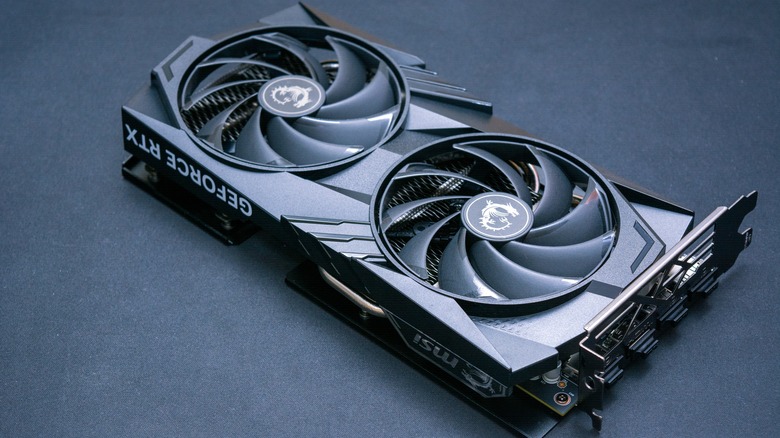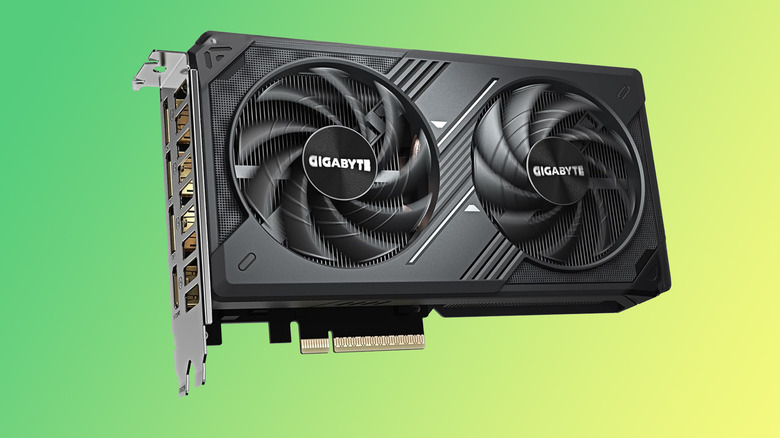Is 8 GB Of GPU VRAM Still Enough For Modern Gaming?
We may receive a commission on purchases made from links.
Video random access memory (VRAM) plays an important part in the performance of your graphics card, and consequently, your entire PC. Unfortunately, for gaming enthusiasts, VRAM has been a topic of contention over the last couple of years. Why? Because many claim that 8 GB of GPU VRAM is no longer enough for modern gaming, meaning AAA titles.
VRAM works similarly to your PC's RAM, but it's built into your graphics card instead. It stores visual assets during gameplay, allowing the GPU to access them quickly; once you turn off the game, the VRAM gets rid of those assets. The stored data includes textures, such as surfaces on 3D models, framebuffers (meaning images that are waiting to be displayed), shaders (this is what tells the GPU how to draw in-game assets), geometry data like vertices and meshes, and post-processing effects.
VRAM is placed close to the actual GPU core and connected via a memory interface referred to as the "bus." The wider the bus, the more memory bandwidth your GPU gets. Bus width also plays a part in performance, because bandwidth determines how fast your GPU can process the data it fetches from the VRAM. It's often said that 8 GB of VRAM is no longer enough if you want to be able to play mainstream games for the years to come. As a PC hardware journalist and a PC builder with nearly 20 years of experience, I'm inclined to agree, and I'll show you why below.
Gamers need more VRAM, but growth has been slow
Unfortunately, if your GPU doesn't have enough VRAM, it needs to turn to your system RAM instead. This is much slower given the distance from the GPU to system memory, and it leads to visual artifacts, stuttering, frame rate drops, or crashes. Meanwhile, modern games increasingly call for more memory: "Hogwarts Legacy," "Forspoken," or "The Last of Us Part 1" are just some examples of games that require more than 8 GB to run smoothly.
VRAM wasn't always such a problem, and only the most recent generations of GPUs seem to fail to keep up with the need for more video memory. We used to see 4 GB and 6 GB GPUs regularly in the past, but that was enough to run AAA games. Not anymore, though, and unfortunately, the growth hasn't been linear.
Nvidia's RTX 3060 is a good example. The GPU had 12 GB of GDDR6 memory across a 192-bit memory bus, and it launched at $329. Meanwhile, the RTX 5060 only offers 8 GB of VRAM and a 128-bit interface, so it has less memory and a narrower bus that stifles the bandwidth, which are some of the many reasons gamers should avoid the RTX 5060. To get that same memory configuration (12 GB and a 192-bit bus), you'll need to spend upwards of $549 on the RTX 5070. Even the 16 GB version of the RTX 5060 Ti has to make do with a 128-bit bus, where a wider interface would've allowed it to perform better.
Why VRAM amount matters
As PC hardware gets more powerful, gamers have turned to 1440p and 4K monitors with much higher pixel density than 1080p displays. However, gaming at higher resolutions requires more VRAM, and these monitors put a lot more strain on the GPU.
8 GB GPUs are enough for 1080p gaming, but only for now. As games continue to introduce more complex assets, higher resolutions become the norm for enthusiasts, and features like ray tracing push VRAM needs even further, 8 GB GPUs will start to fall behind. This is already visible in benchmarks and will become even more of a problem in the next few years.
TechPowerUp reviewed the 8 GB RTX 5060 Ti, highlighting how much VRAM matters at higher resolutions: The card is 0.2% slower than the 16 GB version at 1080p, 3.7% slower at 1440p, and a whopping 15.9% slower at 4K. Even Intel's budget-friendly Arc B580 managed to beat the RTX 5060 at 4K in some benchmarks, primarily because of its 12 GB of VRAM. TechSpot also compared the two cards, and the results were shocking: The 8 GB version of the RTX 5060 Ti only managed to hit 29 fps in "The Last of Us Part II" at 4K, while the 16 GB version hit a very playable 62 fps.
So, while you can just about get away with 8 GB VRAM nowadays, that likely won't be true for long. If you want to future-proof your PC, look for GPUs with 12GB or more RAM, such as the RX 9060 XT 16 GB or the RTX 5060 Ti 16 GB.


